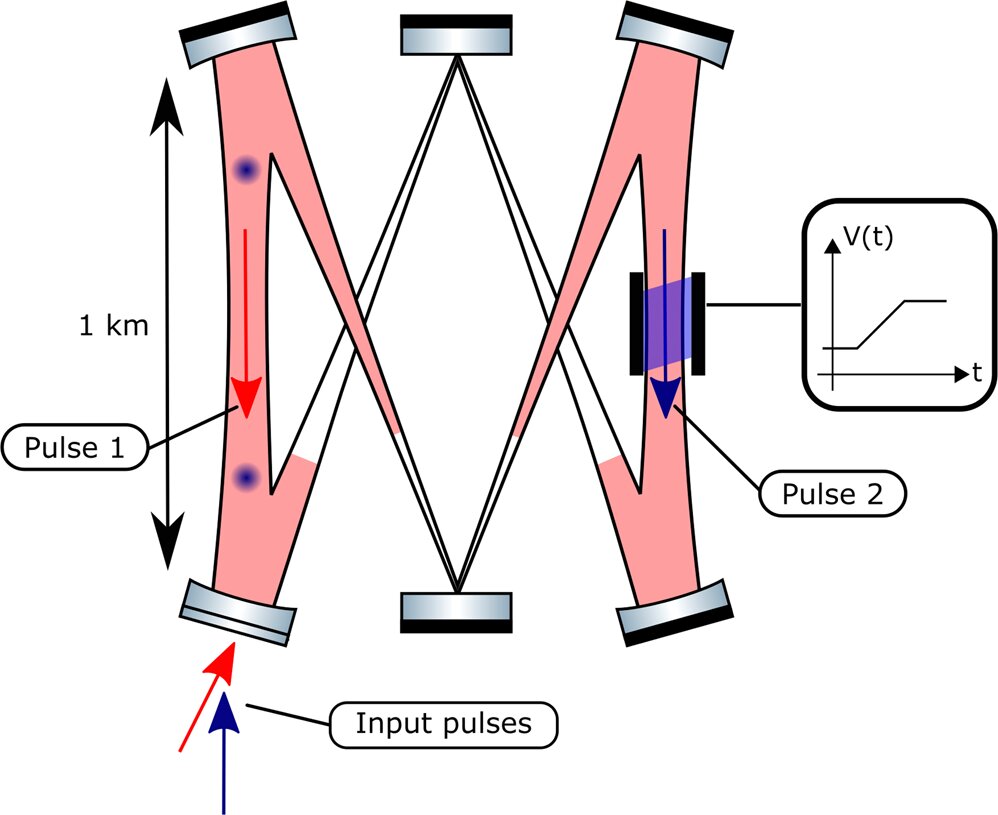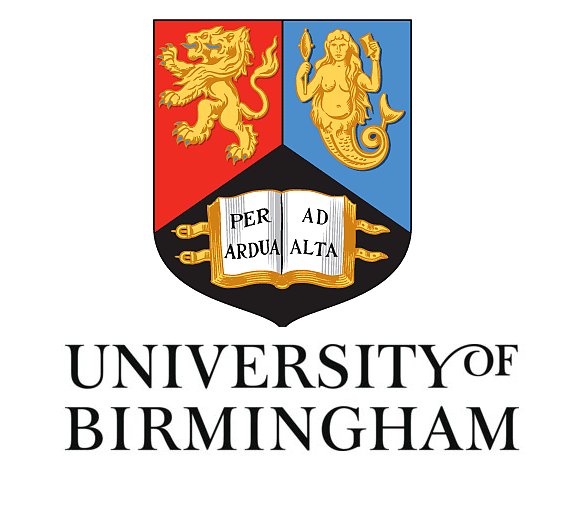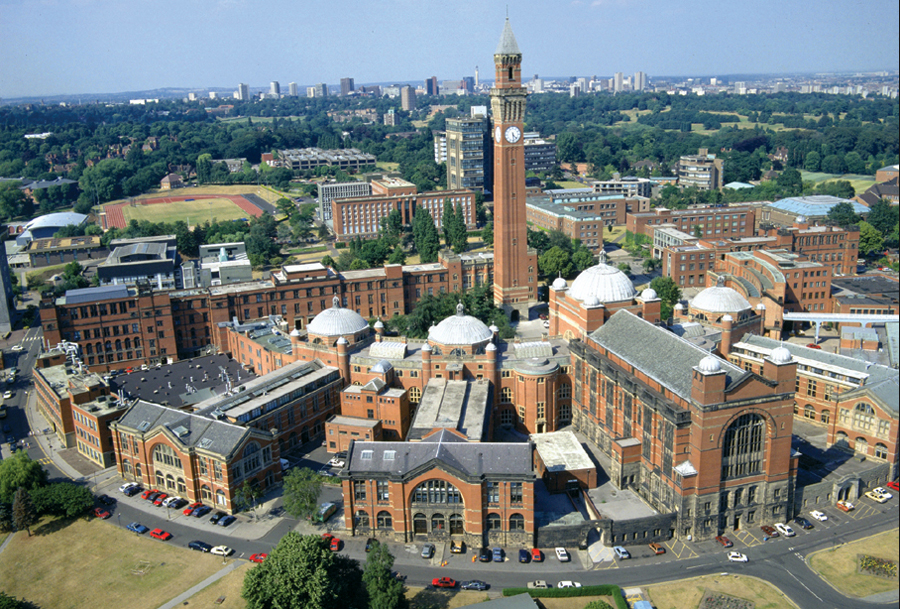From The University of Birmingham (UK)
via

Fig. 1: Circulating pulse interferometry schematic. Circulating pulses occupy each of the two running wave modes in this example cavity, 6 km round trip with a 1 km baseline aligned with gravity. On each round trip, additional light is coupled into the cavity to compensate for losses. Serrodyne modulation, applied through a Pockels cell, shifts the frequency of each pulse on each pass to compensate for Doppler shifts. The pulse durations are maximized within the constraint that only one pulse may pass through the atoms (blue) or Pockels cell at a time. Credit:Communications Physics.
A new concept has been developed that has the potential to assist new instruments in the investigation of fundamental science topics such as gravitational waves and dark matter.
The concept is described in a paper written by UK Quantum Technology Hub Sensors and Timing researchers at the University of Birmingham and published in Communications Physics, and a related patent application filed by University of Birmingham Enterprise.
It proposes a new method of using optical cavities to enhance atom interferometers—highly sensitive devices that use light and atoms to make ultra-precise measurements.
Although itself challenging to implement, the concept presents a method of overcoming substantial technological challenges involved in the pursuit of atom interferometers operating at extreme momentum transfer—a technique which would allow atoms to be placed into a quantum superposition over large distances.
This is key to enabling the sensitivities required for these devices to investigate signals from dark matter and gravitational waves. The exploration of dark matter, and the detection of gravitational waves from the very early Universe is key to developing our collective knowledge of fundamental physics.
The new paper, written by Dr. Rustin Nourshargh, Dr. Samuel Lellouch and colleagues from the School of Physics and Astronomy, describes how synchronization of the input pulses, to realize a spatially resolved circulating pulse within the optical cavity, can facilitate a large momentum transfer without the need for drastic improvements in available laser power.
Investigating dark matter and gravitational waves will not only facilitate a better understanding of the Universe’s history, but will also drive new ideas for improving the future sensitivity of atom interferometers. This will also be relevant to further exploiting atom interferometry in practical applications, such as providing new tools for navigation through enabling increased resilience against loss of GPS signals.
Dr. Rustin Nourshargh, former doctoral researcher at the University of Birmingham and now Scientist at Oxford Ionics, said: “This optical cavity scheme offers a route to meeting the immense laser power requirements for future atom based gravitational wave detectors.”
Dr. Samuel Lellouch, Research Fellow at the University of Birmingham, said: “By overcoming some of the most severe current technological barriers, this original scheme has a real potential to enable disruptive sensitivity levels in large-scale atom interferometers.”
See the full article here .
five-ways-keep-your-child-safe-school-shootings
Please help promote STEM in your local schools.
The University of Birmingham (UK) has been challenging and developing great minds for more than a century. Characterised by a tradition of innovation, research at the University has broken new ground, pushed forward the boundaries of knowledge and made an impact on people’s lives. We continue this tradition today and have ambitions for a future that will embed our work and recognition of the Birmingham name on the international stage.
The University of Birmingham is a public research university located in Edgbaston, Birmingham, United Kingdom. It received its royal charter in 1900 as a successor to Queen’s College, Birmingham (founded in 1825 as the Birmingham School of Medicine and Surgery), and Mason Science College (established in 1875 by Sir Josiah Mason), making it the first English civic or ‘red brick’ university to receive its own royal charter. It is a founding member of both the Russell Group (UK) of British research universities and the international network of research universities, Universitas 21.
The student population includes 23,155 undergraduate and 12,605 postgraduate students, which is the 7th largest in the UK (out of 169). The annual income of the institution for 2019–20 was £737.3 million of which £140.4 million was from research grants and contracts, with an expenditure of £667.4 million.
The university is home to the Barber Institute of Fine Arts, housing works by Van Gogh, Picasso and Monet; the Shakespeare Institute; the Cadbury Research Library, home to the Mingana Collection of Middle Eastern manuscripts; the Lapworth Museum of Geology; and the 100-metre Joseph Chamberlain Memorial Clock Tower, which is a prominent landmark visible from many parts of the city. Academics and alumni of the university include former British Prime Ministers Neville Chamberlain and Stanley Baldwin, the British composer Sir Edward Elgar and eleven Nobel laureates.
Scientific discoveries and inventions
The university has been involved in many scientific breakthroughs and inventions. From 1925 until 1948, Sir Norman Haworth was Professor and Director of the Department of Chemistry. He was appointed Dean of the Faculty of Science and acted as Vice-Principal from 1947 until 1948. His research focused predominantly on carbohydrate chemistry in which he confirmed a number of structures of optically active sugars. By 1928, he had deduced and confirmed the structures of maltose, cellobiose, lactose, gentiobiose, melibiose, gentianose, raffinose, as well as the glucoside ring tautomeric structure of aldose sugars. His research helped to define the basic features of the starch, cellulose, glycogen, inulin and xylan molecules. He also contributed towards solving the problems with bacterial polysaccharides. He was a recipient of the Nobel Prize in Chemistry in 1937.
The cavity magnetron was developed in the Department of Physics by Sir John Randall, Harry Boot and James Sayers. This was vital to the Allied victory in World War II. In 1940, the Frisch–Peierls memorandum, a document which demonstrated that the atomic bomb was more than simply theoretically possible, was written in the Physics Department by Sir Rudolf Peierls and Otto Frisch. The university also hosted early work on gaseous diffusion in the Chemistry department when it was located in the Hills building.
Physicist Sir Mark Oliphant made a proposal for the construction of a proton-synchrotron in 1943, however he made no assertion that the machine would work. In 1945, phase stability was discovered; consequently, the proposal was revived, and construction of a machine that could surpass proton energies of 1 GeV began at the university. However, because of lack of funds, the machine did not start until 1953. The DOE’s Brookhaven National Laboratory (US) managed to beat them; they started their Cosmotron in 1952, and had it entirely working in 1953, before the University of Birmingham.
In 1947, Sir Peter Medawar was appointed Mason Professor of Zoology at the university. His work involved investigating the phenomenon of tolerance and transplantation immunity. He collaborated with Rupert E. Billingham and they did research on problems of pigmentation and skin grafting in cattle. They used skin grafting to differentiate between monozygotic and dizygotic twins in cattle. Taking the earlier research of R. D. Owen into consideration, they concluded that actively acquired tolerance of homografts could be artificially reproduced. For this research, Medawar was elected a Fellow of the Royal Society. He left Birmingham in 1951 and joined the faculty at University College London (UK), where he continued his research on transplantation immunity. He was a recipient of the Nobel Prize in Physiology or Medicine in 1960.



